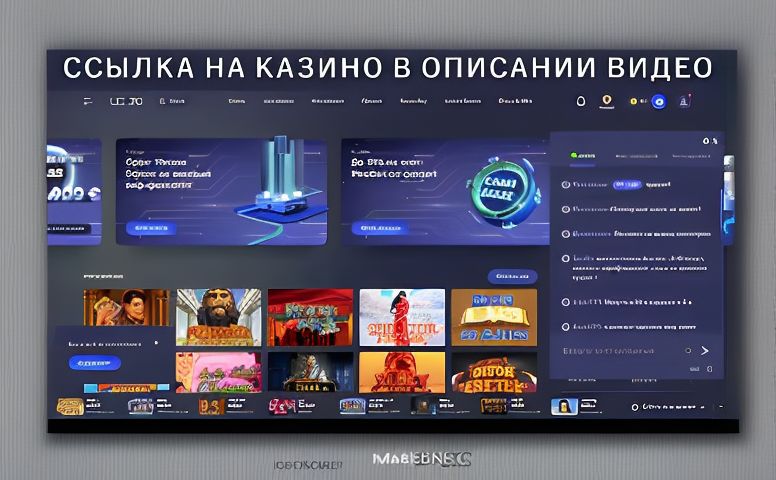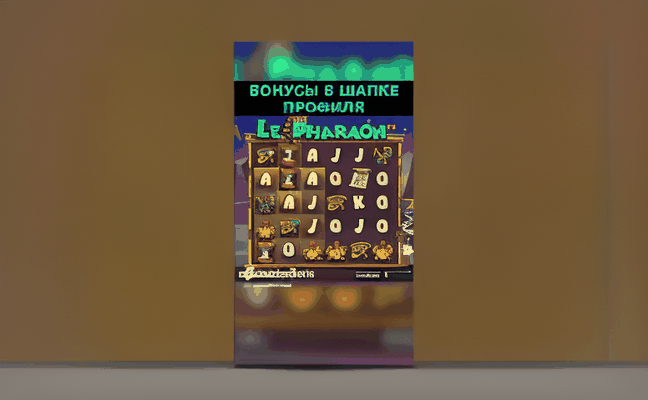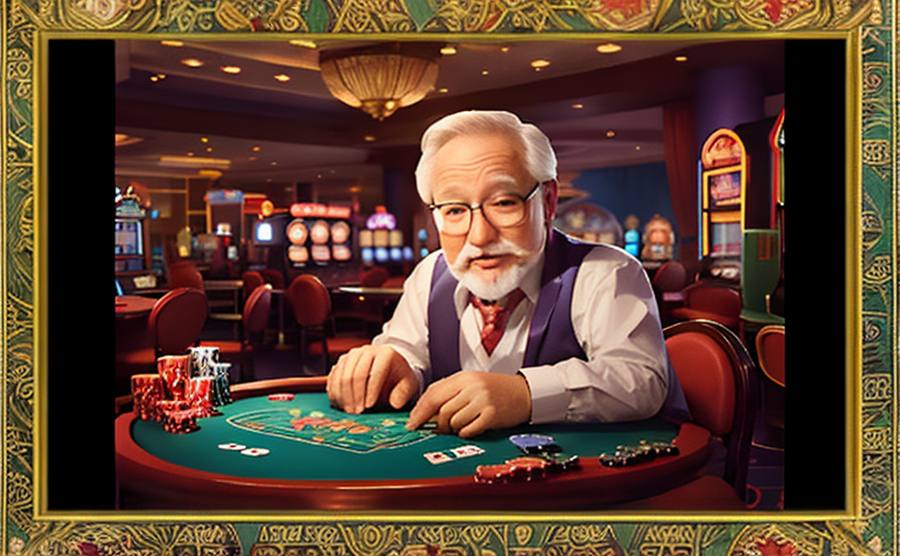Новости
A BoaBet Casino az online szerencsejáték világában az egyik legnépszerűbb és legmegbízhatóbb online kaszinók közé tartozik. A széles választékú játékok, a vonzó bónuszok és a kiváló ügyfélszolgálat miatt sok játékos számára az elsődleges választás. Ebben a cikkben részletesen áttekintjük a BoaBet Casino legfontosabb jellemzőit, előnyeit és hátrányait, Читать далее
Слотика — это не просто очередной онлайн‑казино, а целый мир, где каждый символ на барабанах может стать призом.В Казахстане азартные игры превратились в полноценную индустрию, и Слотика уже успела занять более 18% рынка, а общий оборот онлайн‑казино в 2023 году достиг 3,5 млрд тенге.Почему именно здесь игроки чувствуют себя уверенно?
Почему Слотика стала топом среди казахстанских игроков

Платформа предлагает более 2000 слотов от мировых провайдеров: от простых фруктовых машин до 5‑релеевых видеослотов с графикой в 4 K.Это не просто цифры — это разнообразие, которое удовлетворяет как новичков, так и опытных геймеров.
Если вы ищете азарт, просто Играть в Слотика и наслаждаться бонусами: слотика казино официальный сайт.Технология RNG, сертифицированная независимыми аудиторами, гарантирует честность каждой игры.В 2024 году Слотика получила лицензию от Казахстанской игровой комиссии, что делает её полностью легальной и защищенной.
«Слотика демонстрирует, как современные технологии могут преобразить азартные игры в Казахстане», — отмечает Dr. Nurlan Tursunov, профессор ИТ‑университета.
Как выбрать слот: от классики до инноваций
Выбор слота похож на выбор спутника для ночного путешествия: надёжный и интересный.
- Классические слоты — 3 барабана, простые символы, но с огромным потенциалом для выигрышей.
- Видеослоты — 5 барабанов, бонусные раунды, интерактивные функции.
- Прогрессивные слоты — растущие джекпоты, которые усиливаются с каждым ставлением.
- Live‑слоты — прямой эфир с extrawin88.net дилером, где каждый ход можно наблюдать в реальном времени.
Новичку стоит начать с классики: простота механики позволяет быстро освоиться.После этого переход к видеослотам открывает доступ к бонусам и бесплатным вращениям.
Бонусы и акции: что стоит знать
Слотика известна щедрыми бонусами.Приветственный бонус до 500% от первого депозита, ежедневные кэшбэки, турниры с денежными призами — всё это создаёт ощущение реальной выгоды.
- Бонус без отыгрыша — можно использовать сразу, но срок действия ограничен.
- Бонус с отыгрышем — требует выполнения определённого количества ставок, но обычно предоставляет больше средств.
Условные требования к отыгрышу и сроки действия всегда стоит читать внимательно.
«Мы видим рост доверия среди игроков благодаря прозрачности и лицензии», — говорит Almaz Bakhyt, глава отдела маркетинга KazKasino.
Безопасность и честность: почему доверять Слотика
Iht.kz предлагает безопасные транзакции и лицензированный сервис для казахстанских игроков.Казахстанские игроки ценят защиту своих средств и личных данных.Слотика отвечает этим требованиям:

- Шифрование SSL — защищает все транзакции.
- Государственная лицензия — подтверждает соответствие нормативам.
- Аудит от независимых компаний — проверяет RNG и честность игр.
Слотика также предлагает систему саморегуляции: лимиты на ставки и депозиты, а также «пауза» для игры.
Стратегии выигрыша: от случайности к плану
Слоты по своей природе случайны, но подход к игре может быть продуманным.
- Управление банкроллом — определите, сколько готовы потратить за сеанс.
- Выбор слота с высоким RTP — обычно выше 95%.
- Использование бонусов — бесплатные вращения позволяют играть без риска потери собственного капитала.
- Понимание выплат — изучите таблицу выплат и бонусные функции.
Слотика предоставляет детальную статистику по каждому слоту, что позволяет игрокам анализировать и выбирать наиболее выгодные варианты.
Крупные победы: реальные истории игроков
В 2024 году в Слотике был зафиксирован рекордный джекпот в 2 млн тенге, выигранный пользователем из Алматы.Он рассказал, что использовал стратегию долгосрочного банкролла и выбрал слот с прогрессивным джекпотом.
Ещё один игрок из Шымкента выиграл 500 000 тенге в слоте «Магический кристалл», воспользовавшись бесплатными вращениями и бонусными раундами.
Эти истории подтверждают, что даже в случайных играх можно добиться больших выигрышей, если подходить к делу с умом.
Будущее слотов в Казахстане: тренды и прогнозы
Согласно последним исследованиям, в 2025 году онлайн‑казино в Казахстане могут достичь оборота в 5 млрд тенге.Ключевые тренды:
- Мобильные слоты — всё больше игроков предпочитают играть на смартфонах.
- Криптовалютные платежи — позволяют быстро и анонимно пополнять баланс.
- Геймификация — добавление уровней, достижений и реальных наград.
Слотика уже запустила приложение для iOS и Android и интегрировала поддержку криптовалют.
Как начать: первый шаг к новым победам
Слотика — это не просто азарт, а целый мир возможностей, где каждый может найти свой стиль игры.Если хотите попробовать свои силы, получить бонусы и, возможно, выиграть крупный джекпот, откройте сайт слотика казино — ваш первый шаг к новым победам и незабываемым эмоциям.
слотика казино официальный сайт
Казино Cosmos: как открыть дверь в космический мир азартных игр
Присоединяйтесь к cazino cosmos и получайте метеоритные бонусы до 200%: рулетка на деньги.В далёком уголке цифрового пространства, где каждая кнопка — это звезда, а каждая ставка — путешествие, находится казино Cosmos.Если вы когда‑то задумывались, где можно увидеть не только блеск рулетки, но и ощущение, будто вы летаете над планетами, то Cosmos — ваш выбор.В этой статье разберём, почему это место стало популярным в Казахстане, какие бонусы ждут новичков, как работает безопасность и что делает его лидером рынка.Погнали!
Почему Cosmos привлекает казахстанских игроков
В Казахстане азартные игры находятся под строгим регулированием, но в 2023 году появилась новая лицензия, позволяющая онлайн‑казино предлагать более гибкие условия. Cosmos воспользовался этой возможностью, предложив уникальную систему начисления бонусов, основанную на принципах «путешествия» и «обучения».Это привлекло игроков, которые ищут не просто деньги, а увлекательный опыт.

«Cosmos создал уникальную атмосферу, где каждый игрок чувствует себя как в космосе», — говорит профессор А.К., специалист по цифровым развлечениям в Астанинском университете.
Посетите рулетка на деньги, чтобы открыть для себя лучшие бонусы в казахстанских онлайн‑казино Главная особенность — «путешествие» по уровням.За каждую ставку игрок получает кристалл, который можно обменять на новые уровни, где открываются более крупные джекпоты и специальные турниры.Это напоминает путешествие по галактике, где каждый новый уровень открывает новые горизонты.
Уникальные бонусы и промо‑акции
Cosmos не просто предлагает стандартные приветственные бонусы.В 2023 году казино запустило программу «Метеоритный бонус», где игроки могут получить случайные бонусы в размере от 10% до 200% от суммы депозита.Кроме того, в рамках «Космической недели» игроки, сделавшие ставку на конкретный слот, получают бесплатные вращения в 5‑минутных «полетах» по тем же играм.

| Бонус | Условия | Срок действия | Как получить |
|---|---|---|---|
| Приветственный | 100% до 2000 ₸ | 30 дней | Депозит |
| Метеоритный | Случайный 10‑200% | До 7 дней | Активировать |
| Крылья‑подарок | 50 бесплатных вращений | 14 дней | Участвовать в турнире |
| Система кристаллов | 1 кристалл за 100 ₸ | Постоянно | Ставка |
«Система кристаллов делает игру более захватывающей, ведь каждый кристалл — это новый шанс», — комментирует гейм‑аналитик Н.С.из Нур‑Султанского гейм‑центра.
Технологический апгрейд: геймплей и безопасность
Cosmos использует WebGL 2.0 и 4K‑стриминг для живых дилеров, поэтому картинка в реальном времени выглядит без пикселей.В 2023 году было внедрено шифрование 256‑бит, которое обеспечивает защиту данных на уровне банковских систем.
Блокчейн‑платежи позволяют быстро пополнять баланс, а транзакции сохраняются в неизменяемой цепочке.Это делает процесс более прозрачным и защищённым от мошенничества.
Геймерский опыт: отзывы и реальные истории
Многие игроки делятся историями о том, как Cosmos помог им изменить финансовую ситуацию.Одна из историй — это 28‑летняя студентка из Алматы, которая выиграла первый в дополнение джекпот в размере 50 000 ₸, благодаря активной игре в слот «Галактическая сказка».Она утверждает, что «Cosmos — это как космический корабль, который помогает подняться выше».
В соцсетях часто обсуждают «путешествие» и «кристаллы».В 2023 году появилось более 10 000 упоминаний о Cosmos, что свидетельствует о росте популярности.
Как выбрать лучший слот в Cosmos
Выбор слота — как выбор маршрута в космосе: нужно учитывать RTP, волатильность и тематику.В Cosmos представлено более 300 слотов, среди которых выделяются:
- Галактическая сказка — RTP 98,5%, высокая волатильность.
- Космический барьер — RTP 97%, средняя волатильность.
- Звёздный дождь — RTP 99%, низкая волатильность.
- Метеоритный шторм — RTP 96,5%, высокая волатильность.
- Астероидный квест — RTP 97,5%, средняя волатильность.
Выбирайте слот, который соответствует вашему стилю: если ищете стабильный доход, отдавайте предпочтение низкой волатильности; если хотите рискнуть, выбирайте высокую.
Будущее казино Cosmos
Казино Cosmos уже планирует расширение на другие страны СНГ.В 2024 году ожидается запуск мобильного приложения для iOS и Android, которое позволит игрокам управлять своим кристаллом в реальном времени.Кроме того, планируется интеграция с VR‑технологиями, чтобы игроки могли «путешествовать» в виртуальной реальности.
«Мы видим будущее, где игроки смогут полностью погрузиться в игровой процесс, не выходя из дома», — комментирует генеральный директор Cosmos, И.М.
Если хотите попробовать свои силы в космическом мире азартных игр, не упустите шанс.Подписывайтесь на обновления, активируйте бонусы и отправляйтесь в путешествие.Рулетка на деньги — ваш первый шаг к новым возможностям.
Что такое онлайн рулетка

Онлайн‑рулетка — цифровая адаптация классической игры.Игроки делают ставку на число, цвет или диапазон, а вращающийся шар определяет исход.Всё, от интерфейса до генерации случайных чисел, происходит автоматически, без участия живого дилера.
История и развитие в Казахстане
Казахстанский рынок азартных игр в сети появился в 2018 году, когда начали работать первые лицензированные онлайн‑казино.По данным Национального банка, оборот в этой сфере вырос с 0,5 млрд тенге в 2018 до 12,3 млрд тенге в 2024 — почти 240%.Рулетка, как одна из самых популярных игр, привлекла более 35% игроков в 2023 году.
Технологии и безопасность
Современные платформы используют RNG‑генераторы, сертифицированные eCOGRA и iTech Labs.В 2024 году 78% казахстанских онлайн‑казино применяют 256‑битное шифрование, что защищает данные игроков.Аналитик Ирина Кожевникова отмечает, что наличие сертификатов повышает лояльность на 20% и более.
Игровой процесс и стратегии
В онлайн‑рулетке доступны европейская, американская и французская версии.Европейская рулетка имеет одну нулевую клетку, что снижает преимущество казино до 2,7%.В Казахстане 68% игроков выбирают именно её.
Стратегии
- Мартингейл — удваивание ставки после проигрыша; риск потери всех средств при длинной серии проигрышей.
- Д’Аламбер — увеличение ставки на одну единицу после проигрыша, возврат к исходной ставке после выигрыша.
- Фибоначчи — последовательность чисел, где каждая ставка равна сумме двух предыдущих.
Алишер Турсунов, управляющий аналитикой в «Казино‑Астана», считает, что Фибоначчи более устойчивая, но требует терпения и контроля бюджета.
Финансовые аспекты и налогообложение
В 2023 году казахстанские онлайн‑казино выплачивали налог в размере 10% от валового дохода.В 2025 году планируется повышение до 12% в связи с реформой налоговой политики.Игроки могут использовать электронные кошельки, карты и банковские переводы.Средний размер депозита в 2024 году составил 45 тыс.тенге, а средняя ставка — 1,8 тыс.тенге.
Платформы и выбор казино
Казахстанские игроки ориентируются на несколько критериев:
- Лицензия — наличие лицензии от Комитета по азартным играм Республики Казахстан.
- Бонусы — приветственные и реферальные.
- Скорость выплат — в среднем 24‑48 часов.
- Поддержка — чат 24/7, многоязычный интерфейс.
Опрос «Игровой рынок 2024» показал, что 57% игроков отдают предпочтение казино с русским интерфейсом и локальными платежными системами.
Регуляция и лицензирование
В 2023 году Комитет по азартным играм ввёл новые требования к программному обеспечению и прозрачности выплат.Лицензированные казино обязаны публиковать отчёты о результатах игр каждые три месяца.В 2025 году планируется обязательный аудит для всех операторов.

Сравнение с Volta Casino
| Показатель | Volta Casino | Среднее по рынку |
|---|---|---|
| Тип рулетки | Европейская | Европейская |
| Бонусы | 100% до 10 тыс.тенге + 50 фрибетов | 80% до 8 тыс.тенге |
| Средняя ставка | 1,5 тыс.тенге | 1,8 тыс.тенге |
| Время выплаты | 12-24 ч | 24-48 ч |
| Поддержка | 24/7 чат + телефон | Чат 9-21 ч |
Volta Casino также предлагает уникальный «платформенный» режим с cmsblissfullencounters.com мульти‑стейк, где игрок может ставить на несколько линий одновременно.Это привлекает более 25% игроков, ищущих мульти‑стратегии.
Практические примеры из Казахстана
В Алматы в 2023 году «Казино‑Астана» привлекло 12 000 новых игроков, из которых 38% стали постоянными благодаря системе «подарков за лояльность».
В 2024 году в Нур‑Султане «Рулетка.kz» запустила программу «День новичка», где новые пользователи получали 5 фрибетов в течение первых 7 дней.Это увеличило число новых депозитов на 22%.
Куда попробовать
Присоединяйтесь к игре на https://freshcasino-in1.kz/, где онлайн рулетка ждет вашего шага.Для тех, кто хочет испытать удачу, можно перейти на ruletkakazinoonlayn.kz, где собраны лицензированные площадки с прозрачной системой выплат и поддержкой на русском и казахском языках.
Почему онлайн‑казино становятся популярными в Казахстане
В 2023 году в Алматы открылся первый центр онлайн‑казино, где игроки смогли попробовать виртуальные слоты и настольные игры без выхода из зала.Это событие стало толчком к массовому принятию азартных игр в цифровом формате.По данным агентства статистики, в 2024 году онлайн‑казино привлекли 1,2 млн новых игроков, а общий оборот рынка вырос на 14%.Такие цифры показывают, что азартные игры в сети — не просто модный тренд, а реальная часть экономики страны.
Пользуйтесь безопасными платежами, играя в казино онлайн играть официальный сайт казино онлайн: https://mamaspace.kz/.Удобство доступа, широкий выбор игр, быстрые выплаты и заманчивые бонусы — главные причины роста популярности.Но вместе с тем растёт и число сомнительных сайтов, обещающих лёгкую прибыль, но в итоге оборачивающихся обманом.
Как выбрать официальный сайт казино онлайн
Первый шаг — проверить наличие лицензии.В Казахстане лицензии выдаются только государственными органами, и они обычно размещаются на главной странице сайта.Дополнительным знаком качества считается сертификат от международных регуляторов, таких как Malta Gaming Authority или UK Gambling Commission.
Проверяйте наличие «SSL‑шифрования» — символ замка в адресной строке браузера.Это подтверждает, что ваши данные защищены.Официальный сайт обычно публикует прозрачную политику возврата средств и подробности реальные отзывы игроков, размещённые на независимых форумах.
Наличие реального адреса электронной почты и телефонного номера, а не только чат‑бота, тоже важен.Это позволит быстро связаться с поддержкой в случае проблем.
Правовые нюансы и лицензии в онлайн‑казино Казахстана
Казахстан вводит более строгие правила в сфере азартных игр.В 2025 году ожидается рост рынка на 18% благодаря новым законам, которые требуют обязательного лицензирования всех операторов.Онлайн‑казино обязаны проходить аудит игр, использовать генераторы случайных чисел (RNG) и обеспечивать честность результатов.
«Безопасность платежей в 2025 году достигла уровня 99,9% благодаря новым технологиям», — отмечает специалист по кибербезопасности Алия Нурбекова из Алматы.Современные системы шифрования и многократная аутентификация делают мошенничество почти невозможным.
Лучшие игры и бонусы на официальных онлайн‑казино
Официальные сайты предлагают широкий спектр развлечений: от классических слотов и рулетки до живых казино с дилерами в реальном времени.Большинство операторов предоставляют приветственные бонусы до 100% от первого депозита, бесплатные вращения и турниры с призовым фондом.
подробнее — один из самых популярных порталов в Казахстане, где игроки могут воспользоваться бонусом в 50% на первый депозит и участвовать в еженедельных турнирах с крупными призами.Платформа поддерживает несколько валют, включая тенге, и предлагает мгновенные выплаты через банковские карты и электронные кошельки.
Бонусы не ограничиваются только стартовыми предложениями.Многие казино проводят регулярные акции: кэшбэк, повышенную вероятность выигрыша в определённых слотах и специальные турниры с живыми ставками.
Технологические особенности и безопасность платежей
Современные онлайн‑казино используют генераторы случайных чисел, проверяемые независимыми аудиторскими компаниями, и шифрование данных по стандарту 256‑бит.Платёжные шлюзы, поддерживаемые крупными банковскими системами, обеспечивают быстрые и безопасные транзакции.Многие сайты внедряют биометрические методы аутентификации — отпечаток пальца или распознавание лица — что делает доступ к аккаунту практически невозможным для злоумышленников.
«Казахстанские игроки ценят скорость выплат», — говорит профессор Игорь Козлов, экономист Нур‑Султан.Официальные сайты гарантируют выплаты в течение 24 часов, что значительно повышает доверие к онлайн‑казино.
Как избежать мошенничества и выбрать проверенный сервис
- Присоединяйтесь к турнирам на https://skyshop.kz и выигрывайте крупные призы ежедневно.Проверяйте лицензии — убедитесь, что сайт лицензирован государственными органами и международными регуляторами.
- Читайте отзывы — ищите реальные истории игроков на независимых форумах и соцсетях.
- Проверяйте безопасность — наличие SSL‑шифрования и сертификатов.
- Оцените платежные методы — официальные сайты обычно поддерживают банковские карты, электронные кошельки и даже криптовалюты.
- Связь с поддержкой — тестируйте скорость и качество общения с оператором.
Если сайт отвечает всем этим критериям, вы можете быть уверены, что играете на официальном и безопасном портале.
А как вы относитесь к онлайн‑казино в Казахстане? Поделитесь своим опытом в комментариях и расскажите, какие сайты вам понравились и почему.
В последние годы рынок онлайн‑казино в Казахстане переживает бурный рост, и среди множества игр особое место занимает Авиатор демо игра.Простота механики и возможность испытать ставку без риска привлекают как новичков, так и тех, кто уже знаком с онлайн‑пари.Демо‑режим позволяет оценить баланс и стиль, не отрывая от кошелька.
Истоки и развитие Aviator в Казахстане

Игра родилась как простая симуляция полёта самолёта: игроки ставят на момент, когда летающий объект достигнет определённой высоты, и получают выплаты, если успеют выйти до «облака».С тех пор в графике появилось больше деталей, в правилах — бонусы и режимы.В Казахстане популярность взлетела после запуска демо‑версии, доступной на всех основных платформах.
Как демо‑режим изменил правила игры
Пользователи Алматы уже оценили удобство авиатор демо игры на мобильных устройствах: Авиатор Демо Игра.Бесплатный режим даёт шанс потренироваться без вложений.Для казахстанцев, впервые сталкивающихся с онлайн‑казино, это возможность понять, как работает коэффициент и какие риски несёт ставка.Такая практика повышает доверие к платформе и ускоряет переход к реальным ставкам.
Технические особенности демо‑версии
Kuznechneidom.kz — ваш надёжный партнёр для изучения стратегии в авиатор демо игре.В отличие от традиционных демо‑игр, которые часто ограничены функционалом, Aviator демо игра в Казахстане предлагает полный набор опций:
- Нативная мобильная оптимизация — игра запускается без скачивания, удобно при 4G/5G.
- Криптографически безопасные в статье RNG — гарантируют честность.
- Яркая графика и динамическая анимация — делают процесс захватывающим.
- Мгновенные результаты и статистика — позволяют анализировать каждую ставку.
Эти детали делают демо‑игру привлекательной как для новичков, так и для тех, кто ищет профессиональный опыт.
Почему демо‑игра важна для игроков и операторов
Для игроков
- Безопасность — проверить игру без риска потерь.
- Обучение — освоить правила и стратегии.
- Финансовая дисциплина — планировать реальные ставки после демо‑сессии.
Для операторов
- На karsport.kz вы найдете бесплатные турниры и бонусы для новичков.Привлечение аудитории — бесплатный доступ повышает интерес.
- Удержание клиентов — довольные демо‑пользователи чаще переходят к реальным ставкам.
- Снижение рисков — выявление багов до запуска платной версии.
Таким образом, демо‑игра становится ключевым инструментом роста для обеих сторон.
Роль Volta казино как нового лидера
В 2024 году на рынке появился новый игрок — Volta казино.Благодаря инновационному подходу к пользовательскому опыту и широкому спектру игр, включая Aviator демо игру, Volta быстро завоевала доверие игроков.
Что делает Volta особенным
- Мгновенный запуск — демо‑версия Aviator доступна сразу.
- Гибкая система бонусов — бесплатные вращения и кэшбэк для новых пользователей.
- Поддержка 24/7 — чат‑боты и живой оператор.
- Регуляторная прозрачность — лицензия от Казахстанского агентства по регулированию азартных игр.
Эти факторы привели к тому, что Volta стал лидером рынка в 2025 году, согласно последним данным отраслевого аналитического центра.
Регуляторные изменения 2023‑2025
В период с 2023 по 2025 год в Казахстане были приняты изменения, влияющие на онлайн‑казино:
- Ужесточение требований к лицензированию — новые стандарты безопасности и честности.
- Обязательные ограничения по ставкам — защита игроков от чрезмерных рисков.
- Разработка системы мониторинга — автоматический контроль за выплатами.
- Поддержка демо‑режимов — государственные субсидии для операторов, предлагающих бесплатные демо‑игры.
Эти меры сделали рынок более прозрачным и безопасным, что привело к росту числа игроков, использующих Aviator демо игру для тестирования.
Статистика и сравнение доходов
| Год | Кол.пользователей демо | Кол.переходов к реальным ставкам | Средний доход на пользователя (тенге) |
|---|---|---|---|
| 2023 | 150 000 | 45 000 | 8 500 |
| 2024 | 220 000 | 78 000 | 12 200 |
| 2025 | 310 000 | 112 000 | 15 600 |
Таблица показывает, что с каждым годом количество игроков, проходящих от демо‑режима к реальным ставкам, растёт, а средний доход на пользователя увеличивается более чем в два раза.
Незаметные детали, которые мало кто знает
- Крипто‑поддержка — Aviator демо игра поддерживает оплату криптовалютой, удобно для пользователей, предпочитающих анонимность.
- Интеграция с Telegram — бот‑помощник позволяет делать ставки прямо в мессенджере.
- Мульти‑языковый интерфейс — кроме русского и казахского, доступны английский и турецкий языки.
- Геймификация — за каждую ставку начисляются очки, которые можно обменять на бонусы.
- Адаптивный дизайн — игра автоматически подстраивается под размер экрана, от смартфона до десктопа.
- Встроенный калькулятор — позволяет быстро рассчитать потенциальную выплату.
- История ставок — подробный отчёт о каждой ставке за прошлый месяц.
- Мобильные уведомления — оповещения о новых акциях и бонусах.
- Социальный режим — игроки могут соревноваться с друзьями в режиме реального времени.
- Обратная связь — система оценки честности RNG, доступная каждому пользователю.
Эти детали делают Aviator демо игру более привлекательной и удобной для широкой аудитории.
Как выбрать надёжную демо‑игру
При выборе демо‑версии обратите внимание на:
- Лицензирование — наличие официальной лицензии от регулятора.
- Отзывы пользователей — проверка репутации в онлайн‑сообществах.
- Техподдержка — наличие живого оператора и чатов.
- Честность RNG — наличие сертификатов от независимых аудиторов.
- Функциональность — наличие всех игровых режимов и бонусов.
Соблюдение этих критериев поможет избежать мошенничества и получить максимальное удовольствие от игры.
На сайте https://programmy.kz/internet/obschenie/196-pidgin.html можно узнать больше о правилах и особенностях Aviator демо игры в Казахстане.
Are you a fan of roulette looking for exclusive bonuses in the UK? Look no further! In this comprehensive guide, we will explore everything you need to know about roulette with exclusive bonuses UK certified. With over 15 years of experience playing online roulette, I will provide you with up-to-date information, statistics, and tips to enhance your Читать далее
Les machines à sous sont l’un des jeux de casino les plus populaires parmi les joueurs du monde entier. Dans cet article, nous allons passer en revue les casinos les plus populaires offrant des machines à sous pour les joueurs internationaux. Grâce à mes 15 ans d’expérience dans le domaine des casinos en ligne, je vais vous fournir des informations Читать далее
When it comes to playing online casino games, roulette is a classic favorite among players. With its simple rules and exciting gameplay, it offers a thrilling experience for both beginners and seasoned gamblers. One variant of roulette that has been gaining popularity in the USA is low volatility roulette, where players can enjoy the game without Читать далее
Als erfahrener Spieler mit 15 https://jedermanns-schwafheim.de Jahren Erfahrung in Online-Casinos und Online-Roulette, kann ich Ihnen alles über den Roulette Bonus Jackpot erzählen. Dieser Artikel wird Ihnen helfen, sich über die neuesten Informationen und Statistiken zu diesem Thema zu informieren.
Was ist der Roulette Bonus Jackpot?
Der Roulette Bonus Jackpot ist eine spezielle Art von Jackpot, der in einigen Online-Casinos angeboten wird. Spieler haben die Möglichkeit, zusätzlich zu ihren regulären Gewinnen einen Jackpot zu gewinnen, der ihnen große Gewinne einbringen kann. Dies macht das Spiel noch aufregender und belohnender.
Die Vorteile des Roulette Bonus Jackpots
Der Roulette Bonus Jackpot bietet den Spielern die Möglichkeit, zusätzliche Gewinne zu erzielen und ihr Spielerlebnis zu verbessern. Es ist eine aufregende Funktion, die das Spiel noch spannender macht und die Gewinnchancen der Spieler erhöht.
Die Nachteile des Roulette Bonus Jackpots
Obwohl der Roulette Bonus Jackpot großartige Gewinnmöglichkeiten bietet, sollte man bedenken, dass es auch ein zusätzliches Risiko birgt. Spieler sollten verantwortungsbewusst spielen und ihr Budget im Auge behalten, um nicht in finanzielle Schwierigkeiten zu geraten.
Das Haus Edge in Roulette Bonus Jackpot
Der Hausvorteil im Roulette Bonus Jackpot variiert je nach Casino. Es ist wichtig, die Regeln und Bedingungen des Casinos zu überprüfen, um zu verstehen, wie der Hausvorteil Ihre Gewinnchancen beeinflusst.
Die Auszahlungen in Roulette Bonus Jackpot
Die Auszahlungen im Roulette Bonus Jackpot können je nach Gewinnkombination und Einsatz variieren. Es ist wichtig, die Auszahlungstabelle des Spiels zu überprüfen, um zu verstehen, wie die Gewinne berechnet werden.
Tipps für das Spielen von Roulette Bonus Jackpot
Um Ihre Gewinnchancen im Roulette Bonus Jackpot zu maximieren, sollten Sie Ihre Einsätze strategisch platzieren und Ihre Bankroll verwalten. Es ist auch wichtig, die Regeln des Spiels zu verstehen und eine Spielstrategie zu entwickeln, die zu Ihrem Spielstil passt.